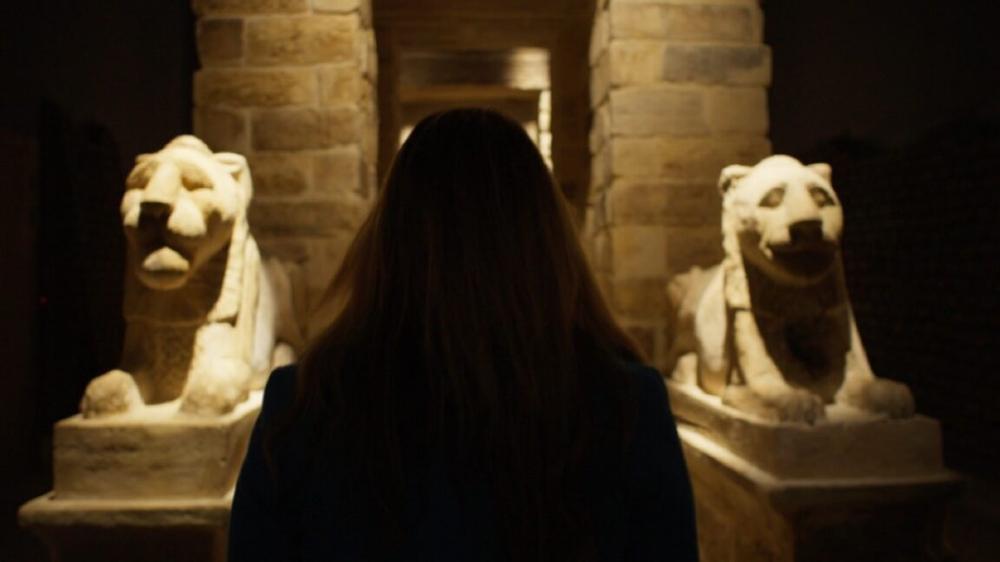Doomed Egyptian queen Cleopatra has captured the imaginations of people all over the world for centuries. Archaeologists have long sought to locate her tomb, which she shared with her lover, Mark Antony, per popular legend. Thus far the search has been unsuccessful, although many believe she would have been buried near the royal palace in Alexandria, Egypt.
National Geographic Explorer Kathleen Martinez thinks she might be on the verge of locating Cleopatra's final resting place at a site called Taposiris Magna. Her 20-year journey (and counting) to prove her hypothesis—and the exciting new discovery of a submerged ancient port several miles off the Mediterranean shore that was likely once part of that temple—are chronicled in Cleopatra's Final Secret, a new documentary film from National Geographic.
Martinez has a degree in archaeology but initially became a criminal lawyer. She brought that legal training to bear on the question of the location of Cleopatra's tomb, treating it as she would a forensic case. "I tried to understand her personality, who were her friends, who were her enemies," Martinez told Ars. "She was a strategist and she always had a Plan A and a Plan B." It simply made sense to her that Cleopatra would have brought that same strategic thinking to orchestrating her death. Martinez suggested that the queen arranged for loyal subjects to transport her body through secret tunnels to a hidden final resting place.
Martinez knows firsthand how difficult it can be for inmates to receive food and other items from family and friends, all of which are searched before reaching the intended recipient. Cleopatra was imprisoned in her palace, and legend has it that an ally brought her a basket of figs, and hidden within was the cobra that gave the Egyptian queen that fatal bite. Martinez pondered why Cleopatra would have bothered with an actual cobra when all she needed was the venom, mixed in with food or drink.
Martinez believes it was because the cobra is associated with Isis in Egyptian mythology, and Cleopatra had fashioned her image as being a human representation of the goddess. "It was the symbolism," said Martinez. "She was dying, but she was dying as Isis, as a goddess, not as a prisoner. And this is how she became a legend, a myth." It stood to reason, then, that given the choice, Cleopatra could have arranged for her body (and that of Mark Antony) to be buried in a temple of Isis—a conclusion supported by Petrarch's writings, among other sources.
A temple fit for a queen
The next step was to create a map of ancient Alexandria marking the locations of the temples that weren't too distant from the royal quarters where Cleopatra was a prisoner. Of those, Taposiris Magna—located in the coastal town of Borg El Arab, about 30 miles west of Alexandria—was the only temple for which scholars have almost no information: who built it, whether it ever functioned as a temple, to whom the temple was dedicated and so forth. "That was a red light, not for the archaeologist, but for the lawyer in me," said Martinez.
Thus began Martinez's two decades of work to excavate Taposiris Magna. Among her more significant findings were the discovery in 2006 of foundation plates dedicating the temple to Isis, along with royal artifacts and many coins bearing Cleopatra's likeness. Last year her team unearthed burial shafts with mummies, tunnels, and another trove of artifacts—including a delicately carved head Martinez believes is a likeness of Cleopatra, although this has yet to be confirmed. All this strengthened Martinez's conviction that she was on the right track for locating Cleopatra's tomb—particularly since one 4,300-foot tunnel led directly out to the Mediterranean Sea.
Martinez concluded that perhaps part of the original temple site was now submerged underwater—and Cleopatra's tomb might be among those submerged structures. That said, "It's one thing to have an idea and another to make the discovery," she said. "We already have archaeological evidence that important trade and commercial activities were taking place in Taposiris Magna. But having this information doesn't mean that we will make the discovery. When I was standing a few years ago in front of the Mediterranean Sea, I was really scared that I would not ever be able to make the discovery. It's open sea, which is very dangerous, and I didn't have any experience searching underwater."
One of her team members suggested she contact someone who did have experience searching underwater: famed oceanographer Robert Ballard, best known for his 1985 discovery of the submerged wreck of the HMS Titanic. Ballard accepted Martinez's invitation to join the project, came to Egypt to check out the site, and immediately told her he thought she was on the right track with her search. That didn't make the undertaking an easy one, but the Egyptian Navy also pitched in to help.
A submerged ancient port
Still, the clock was winding down for that excavation season. Then divers found manmade stone pockets, once used to store fishing gear, a sign that this might have been a shoreline in Cleopatra's time. Sonar revealed ancient relics along the sea floor, including a series of colossal structures standing 20 feet high and arranged in rows, as well as several anchors and amphora. When the first anchor was found, Martinez recalled, one of the cameramen became so excited he jumped right into the water. And that 4,300-foot tunnel pointed directly at the submerged site. Divers also uncovered a basalt base that may have been a pedestal for a statue, as well as three pillars they dubbed the "Three Sisters."
The discovery of the port suggests that Taposiris Magna was both a significant religious center and a maritime trading hub. Now that Martinez and Ballard and the rest of the team have successfully mapped the area and identified five areas showing clear signs of human activity, the next step is to explore further with actual excavations. That's a major undertaking given that the structures are buried beneath thousands of years of sediment, and that sediment must be removed in order to find out exactly what is underneath.
But Martinez is game and plans to start with the "Salam 5" feature, consisting of several tall rectangular stone structures. While none of this is definitive proof, "nobody can tell me that Cleopatra is not at Taposiris Magna," Martinez told National Geographic. "To say that, you have to excavate the whole area and not find her. I'm not going to stop. For me, it is a matter of time."
Cleopatra's Final Secret premieres on September 25, 2025, on National Geographic and will be available for streaming the next day on Disney+ and Hulu.

 YouTube is reportedly mass restricting accounts and ramping up age verification
YouTube is reportedly mass restricting accounts and ramping up age verification